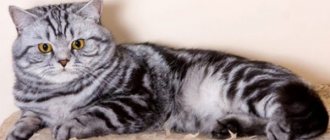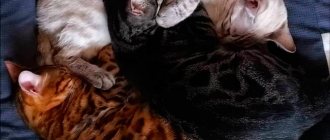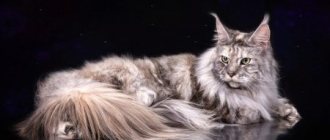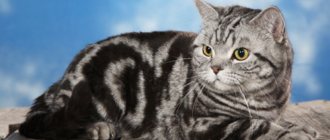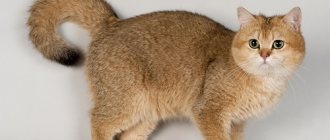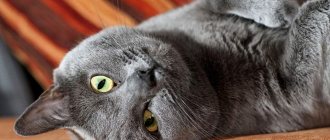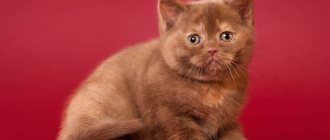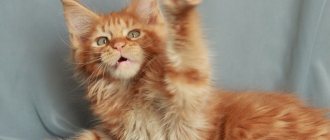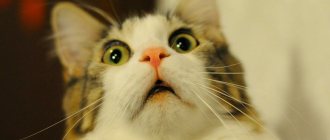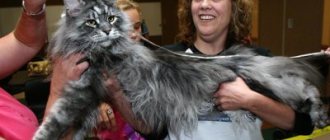British marbled cat - maintenance rules and description of the breed
The British marbled cat is considered one of the most ancient and beloved breeds. The animal has an interesting origin story. The future owner should familiarize himself with the standard of the reference representatives, know what shades of merle color exist, what is the character and health status of the cat. The owner also needs to master the skills of care and feeding, and if you plan to visit an exhibition, study the issues of reproduction.
According to breeders, a British merle cat is considered the most valuable and expensive among the representatives of its breed.
Scientific classification
- Kingdom: Animalia (animals)
- Phylum: Chordata
- Class: Mammalia (mammals)
- Order: Carnivora (predatory)
- Family: Felidae (felines)
- Genus: Pardofelis (marbled cats)
- Species: Pardofelis marmorata (marbled cat)
Marbled cats belong to the subfamily of small cats , they separated from a common ancestor with big cats approximately 9.4 million years ago. They were once considered close relatives of the clouded leopard due to many morphological similarities. However, genetic analysis has shown that the marbled cat is more closely related to the Temminck's cat (Asian golden cat) and the Kalimantan cat of Borneo.
Where did the British come from?
The first ancestors from which the marbled Britons descended were brought to the territory of the British Isles from Rome and Egypt. The cats were distinguished by their powerful physique and high hunting instinct. The locals liked this because the cats began to destroy rodents that were spoiling the harvest. People and animals got along well, as cats had a proud disposition and unpretentiousness. For several centuries no one studied the breed. In 1889, an exhibition was held in London where the British white cat was presented. Real interest arose only in the 20-30s of the twentieth century, when, according to a program specially created by felinologists, they began crossing animals and breeding the breed. In 1980, the breed was recognized by the International Federation of Cat Fanciers. The marbled cat was bred through selection.
Description: what does the standard look like?
Variety of colors
The most famous color is black marble on silver, where the main tone is white-silver with a clear black pattern. In addition, cats of the British breed have the following colors:
- Gold marble (black marble on gold). There is a black and brownish pattern on a golden brown background.
- Chocolate marble. There are clear brown stripes against the café au lait background. The chocolate shade has varieties of silver (light base color and brownish pattern) and golden, where yellowish predominates in the shades.
- Blue marble. Includes a combination of dark and light gray.
- Red marble. This is a bright red cat with a characteristic pattern of a darker tone.
- Red silver marbled cats. They are distinguished by a light base color and light brown stripes.
Return to contents
Breed standard
The British marbled cat breed cannot have fold ears, so kinks in the ears are considered a deviation. Disadvantages include an incorrect bite, a narrow muzzle, a hump on the nose or a sign of brachycephalic breeds, and a pronounced pinch. Marbled kittens must be tabby, any baby from the litter must have short hair. The basic requirements for the breed are shown in the table:
| Body part | Characteristic |
| Body | Medium size, proportional, muscular |
| The chest is developed, the shoulders are wide, the back is straight | |
| Weight up to 8 kg | |
| Head | Rounded, cheeks pronounced |
| The nose is straight, the nose is large | |
| The transition from the forehead to the muzzle is pronounced, but not too obvious | |
| Ears | Small, pyramidal, widely spaced, rounded tips |
| Eyes | Round, wide open |
| Marble cats have a main shade of honey-yellow; cats with blue eyes come only in point color | |
| Paws | Thick, powerful, straight, rounded pads |
| Tail | Medium, thick, tapering to the tip |
| Wool | Short, loose fitting, thick |
| Undercoat present |
Return to contents
Spotted and striped colors (tabby)
All varieties of the “wild” British tabby color are characterized by an “M” on the forehead, “necklaces” on the chest, and dark stripes on the muzzle. The colors are presented here in subgroups:
- Striped. This color is called tiger, sprat or mackerel (mackerel). This is the most common tabby color of the British breed. As the name implies, the color of the cat resembles that of mackerel, sprat or tiger. There is a dark stripe along the ridge and part of the tail, and on the sides there are stripes that should not turn into spots.
- Spotted. This Briton resembles a small leopard. There is a dotted stripe along the spine, clear and bright spots on the sides, and stripes on the cheeks.
- Marble. On light wool there are dark patterns, curls and circles. A contrasting pattern is valued, the details of which do not intersect with each other.
- Silver tabby. The undercoat is white-silver, on the guard hairs there is a black pattern: spotted, striped, marbled.
- Golden tabby. The undercoat is apricot, on the guard hairs there is a bright red pattern: striped, spotted, marbled.
- Torbiko. A rare color consisting of three colors - white, tortoiseshell and tabby. On a snow-white background there will be individual spots of color with a spotted-striped pattern.
- Thorby. The cat's coat is tortoiseshell: black-red, chocolate-red, cinnamon-red, fawn-cream, blue-cream, lilac-cream. A striped pattern is visible under this color.
Marble Tabby:
“Wild” tabby color:
Silver Tabby:
British tabby color:
Character and behavior
Marble British women are distinguished by restraint and prefer independence. That’s why they don’t tolerate being squeezed or picked up. The cat loves company, but sits close to family members alone. In the absence of the owner, he feels great and mostly sleeps. He has a high intelligence and his own opinion, therefore, if the pet is not raised from childhood, the character of British marbled cats can deteriorate. They are laconic, rarely meow and persistently ask for something. They are non-aggressive and balanced, but they remember insults for a long time and ignore the offender for a long time. They are very adamant in their decisions and intentions, so the owner should show restraint, affection and patience towards the pet.
Breeders recommend raising a British cat with marbled coloring from 1.5-2 months to 1 year. A sleeping animal should not be awakened, otherwise the cat will become irritable, so the breed is not suitable for families with small children. Has a tendency to do dirty tricks, so it is better to remove flower pots and expensive decorative items. They are curious, love to climb on closet shelves and “check” bags. There must be a scratching post in the room, otherwise the cat will ruin the furniture.
Asian tabby personality
Shorthair cats are sociable and friendly. They are calm, kind, agile and cheerful. They get along well with children and other pets, including dogs.
Animals are not vindictive, they quickly forget an insult and, in general, are not aggressive. Asian girls are easy to train: by the age of one they know how to and how not to behave in the house.
Tabby has impeccable manners and rarely causes unnecessary trouble to his owner. Cats are suitable for busy people, as they can easily tolerate long periods of loneliness and do not require increased attention. The animal is unobtrusive, meows gently and quietly, perfectly senses the emotional mood of a person, easily becomes attached to family members, so over time it becomes a friend to everyone.
Of particular note is the sensitive nature of the Asian tabby towards cruel treatment - rudeness is taken to heart, which can lead to mental trauma. At the same time, cats are usually calm, and it is almost impossible to get them angry.
The Asian tabby is a very active and playful cat breed. From an early age, babies love to jump, run and play pranks; they carry small things in their teeth and hide them in a secluded place, and also gladly involve family members in active games. But over the years, pets become calmer, preferring to relax in a cozy place and chase the ball.
Care and maintenance do not cause much trouble, and tabbies feel great both with a single person and with a large family.
Health status
The Fold cat has many genetic diseases, which are not observed in the British marble cat. Such cats live up to 20 years, have strong immunity, and rarely get sick. However, they catch cold quickly if left in the cold or draft. As well as marbled, blue, black and white British kittens and adults may suffer from the following diseases:
Animals have a strong immune system, but can suffer from diseases such as obesity.
- Obesity. Representatives of the breed are lazy and sedentary, which contributes to excess weight. This negatively affects the cardiovascular system and joints.
- Cardiomyopathy. Characterized by thickening of the heart muscle and poor circulation.
- Hemophilia. This is a bleeding disorder that can cause prolonged bleeding and lead to anemia.
- Polycystic kidney disease. Cysts form on the organs, gradually replacing the parenchyma, which leads to dysfunction.
- Tartar. The merle shorthair is prone to plaque formation on the teeth, which is dangerous for the development of gingivitis and periodontal disease.
Return to contents
Maintenance and care
Marble coloring in cats, like other shades of British cats, includes grooming. You should comb 1 rub. in 7-10 days, use a comb with medium teeth with rounded tips. A furminator is suitable because the cat has a thick undercoat. Ear and eye hygiene should be carried out at least once every 5-7 days so as not to upset the balance of natural microflora. It is recommended to brush your teeth daily with special zoopastes - “Denta-Kiss”, “Tropiclean” gel, “Sentry”, “Beafar”, “Trixie”. The cat must have toys and a scratching post. The British are squeamish, so the tray should be changed immediately, and the filler should be wood or bentonite.
How to style
In order for the decorative layer to retain its attractiveness, it is important to lay the material correctly. Before laying, it is necessary to prepare the base, for which the following activities are carried out:
- The selected plot of land is cleared of weeds.
- Remove the top, fertile layer of soil, approximately 10 cm.
- The base is compacted, then a layer of fine crushed stone (not decorative) with sand is poured to ensure water drainage.
Path and rock gardenSource paysagiste-lyon.fr
- Geotextiles are laid on the gravel. This is an important step that should not be abandoned. Geotextiles will act comprehensively: they will strengthen the soil, prevent water from accumulating, and prevent weeds from germinating.
- If you are preparing the base for a walkway or flowerbed, install fencing to help maintain the shape. The edging can be stone, brick, plastic, wood, galvanized steel.
- Marble chips are poured onto the prepared area; the surface is leveled with a rake. The layer should be slightly lower (0.5-1 cm) than the surrounding surface.
Decorating a walkway from marble chipsSource priroda-kamen.ru
About design ideas from marble chips in the following video:
British merle color: features of the breed
The first cat show, held in 1879 in London, was attended by the British. Since then, plush animals have gained considerable popularity, as kittens were actively bought by foreign breeders and taken outside the country. The breed, despite its long existence, was officially recognized only in 1950.
At the end of the 70s of the last century, a document was created prohibiting breeding them with any other felines. And in 1980, aristocrats received recognition from the FCA Association.
According to the standard, a purebred individual must have:
- Proportional, strong body with clearly developed muscles, squat and dense.
- Large head with wide-set, medium-sized ears (rounded tips).
- A fold around a short massive neck.
- Big round eyes. The color of the iris is predominantly amber-orange, less common is green and blue. Babies have gray-blue eyes, changing color as they grow older.
- Wide chest.
- Well-defined cheekbones, pronounced cheeks, developed chin and wide nose.
- Thick undercoat.
- The coat is short, dense with hairs of equal length. It feels like plush.
- Neat, strong, rounded paws corresponding to the body type.
- Fleshy, medium-length tail with a rounded tip and a wide base.
The British are distinguished by their long lives, often reaching 15-20 years of age. The weight of an adult animal ranges from 5 to 8 kg; height is not indicated in the standard, but must correspond to a dense constitution.
Top cat breeds that are very similar: could you tell the difference?
While felinologists argue whether or not to recognize some cat breeds as separate, we will simply admire their diversity.
Siamese cats are confused with Thai and Burmese cats, which also have a point color - light coat with darkening on the face, ears, paws and tail. The peculiarity of the color is temperature-dependent albinism: animals with this trait produce little pigment in warm parts of the body, and more in cold parts. And yes, all color-point cats are carriers of this gene, so the similarity of the breeds is no coincidence.
The Siamese cat has a long curved body with a thin “whip-like” tail, a narrow wedge-shaped head, large ears and bright blue eyes. The Siamese acquired this oriental sophistication not at all in the East, but as a result of selection work in the USA, where representatives of the breed ended up in the 1920s. The breed that until the 20s of the last century was called Siamese, and now - Thai. Simply put, the Thai cat is an old type of Siamese cat, preserved by enthusiastic hobbyists and separated into a separate breed.
Thais have a shorter, more compact and muscular body, smaller ears, medium-length legs, and an “apple” shape of the head rather than a narrow wedge. In English they are called apple-headed.
But Burmese cats are a long-haired version of either Siamese or Thai (most likely the latter) - they are distinguished by white “gloves” on dark paws. They say that in the old days, white yellow-eyed cats lived in a Buddhist temple - they guarded a golden statue with eyes made of sapphires. According to legend, the cat of one of the monks defended the relic from robbers and died. When the robbers were celebrating their victory, the cat suddenly came to life and moved onto its owner’s snow-white head. The cat's fur turned from white to gold, his eyes turned blue, and the tips of his paws turned white, like a monk's gray hair.
Probably only specialists do not confuse these gray beauties - the cats are so similar. Short gray coat, graceful shape, balanced parameters of the body, limbs, neck, head and tail. No collars, no tassels, no spots, gray nose and paw pads.
The first difference is the color of the eyes: in Russian blue cats it is emerald green, in Korats it is yellowish or even amber. In addition, the eyes of Korats are set slightly differently and are more prominent.
These cats also have different coat quality. The classic Russian Blue is plush to the touch, because it has a double coat - the breed is northern, with Arkhangelsk and even Norwegian traces. But Korats are native Thai cats; they have no undercoat and a much lighter coat.
The British have a noble blue color and are very similar to their French counterparts. Even the authoritative English felinological association refuses to recognize Chartreux (Carthusian cats) as a separate breed. Well, these are things of the past: some French kings were not really recognized by the British monarchs either.
The fact of breeding Carthusian cats in the Chartreuse monastery is recorded in sources that are seven centuries old. The British breed was recognized as such just over a hundred years ago, when the British needed their own national breed, and the strong round-headed street cats typical of England, which are believed to have been brought to the islands by the Romans, were taken as a basis.
British cats are larger and more “faced” than Carthusian cats, they have many color options, they live longer: 20 years is not a record, but almost the norm.
Charteuses are almost lilac in color and have yellow eyes - some representatives look very aristocratic.
Features of color and types of harlequin British
During the First and Second World Wars, the British population was in danger of extinction. To quickly restore the livestock, breeders added fresh blood, crossing English immigrants with Persians, exotics, Russian Blues, Burmese, Scottish Folds, and Chartreuses.
As a result of experiments, the breed was improved, and color variations expanded. Today there are more than 200 species.
The most popular are:
- Plain (solid) – basic. These include black, chocolate, cream, blue, red, white, purple.
- Tortoiseshell. This species is characterized by spots of two colors, evenly distributed throughout the coat.
- Particolors. The combination of white with the main color, this group includes harlequins, bicolors, etc.
- Golden - appeared recently, divided into shaded and ticked.
- Smoky – characterized by balayage hair coloring, pigmented only at the ends and not dyed at the root. Available in two versions - chinchilla and smoky.
- Color point - light main fur with dark spots in certain places, was inherited by the British from the infusion of Siamese blood.
- Patterned (tabby) - the standard recognizes the brindle, ticked, marbled, spotted variant.
- Silver – available in ticked and shaded form.
The tabby color to which the marbled variety belongs takes its name from the province of Attabiya (Baghdad, Turkey), famous for the production of striped fabric. It is generally accepted that such wool is the result of the presence of forest cats or Nubian dun cats in the British family.
Types of tabby patterns
There is a classification of tabby patterns, which includes 4 main types: ticked, striped, classic and spotted. They are also called Abyssinian, mackerel, marbled and leopard, respectively.
Table 1. Tabby color types
| Color name | Ring pattern on neck and tail | Drawings on the torso |
| Ticked | Almost invisible, not pronounced in all breeds. The tip of the tail is predominantly dark | The presence of so-called “freckles”, also faintly expressed |
| Striped | Narrow frequent stripes | Thin stripes, often repeated throughout the body, as well as along the vertebral ridge |
| Classical | Large, not always clearly defined | Wide, uneven stripes with curves, spots, and intermittent areas |
| Spotted | Wide, not very visible, interrupted, open | Spots of varying sizes creating the appearance of broken lines |
Ticked
The most subtle and inconspicuous of all tabby colors. At first glance, it seems that such cats are monochromatic - the pattern is clearly expressed only on the face, paws and tail, but the color of their coat is not uniform. There are light stripes, spots or “freckles” throughout the body, which differ from the main color by only a few tones. Mostly representatives of the Abyssinian breed have a similar color, which is why the ticked color received such a second name.
Ticked is the most inconspicuous of all tabby colors.
Striped
The brindle or mackerel color is characterized by the presence of bright narrow stripes, often repeated throughout the body. This type received its second name due to a certain similarity with the color of mackerel - striped fish. The pattern is clearly defined, often starting at the ridge line, going down to the belly in numerous branches. The color of the stripes clearly contrasts with the main color of the coat.
The mackerel color is clearly visible on the cat's fur.
Classical
Marble pattern is considered one of the most beautiful. Wide linear, spiral or graphic patterns have indistinct outlines on the neck and paws, becoming more pronounced on the back and sides of the animal. The body is often decorated with large spots, curls, uneven patterns, designs reminiscent of human eyes, butterfly wings, and oyster valves. The color of the patterns clearly contrasts with the main tone of the coat, which can be any shade except white.
Marbled Tabby
Spotted
The stripes of spotted cats are practically absent and are intermittent and short. The patterns predominantly consist of successive dots, spots and blots. The color of the patterns is bright, slightly or very different in tone from the main color of the coat. Representatives of this type resemble small leopards.
Spotted tabby color
Rarer variants
Although most tabby cats fall under the above classification, there are many exceptions that do not fit into this classification. In the variety of designs and shapes, one can highlight examples of rare beautiful types:
- rosette Looks like leopard print. The spots are larger, have a clear edge of a darker color in the form of an uneven outline and a lighter center. Both tones are usually different from the base coat color;
- tortoiseshell. The uniqueness of the tortoiseshell tabby is that the main color of the animal is two-color (black and yellow shades, as a rule). The drawing does not have a clear order and is not expressed too clearly;
- calico. A third primary color is added - white (on the paws, chest, tail or muzzle, as a rule). The pattern looks more like spots or short thin stripes. Because of this, the second name for the color is spotted with white;
- patched Combines the characteristics of the two previous subspecies. A cat can be both tri-colored and white and spotted, with very large spots alternating with each other like patches. In each individual spot, both the main color and the color of the pattern change. The color is found predominantly in cats;
- links point. The cat seems to have accents from the drawing. Moreover, only some details are painted (muzzle or ears, tail, paws, chest or spine line).
Character and habits of marbled British
The British are intellectuals, they can determine the owner’s mood by their voice and gestures, and by a person’s elevated tone they quickly realize that they are doing something illegal. Imposing, dignified, calm cats are not prone to aggression, rancor, or mischief, but at the same time they know how to protect their boundaries and will not allow their person to be treated unceremoniously.
They are independent, you should not expect annoying affection, stormy meetings, or lightning-fast appearance at the first call from them. It seems that this cat has “his own person” and patronizes him condescendingly. But behind this external equanimity lies a tender devotion to all family members.
They get along well with other cats and dogs, as long as they don't pester them too much. They do not need constant company; the British can be called the introverts of the cat world.
Characteristics of the Asian Tabby
English tabbies are peaceful, smart and active. Asian cats love affection, communication and games. But cats will not require immediate attention; they will wait until the owner is free and can devote time to them. In general, representatives of this breed are very well-mannered, reserved and filled with self-esteem.
Asian tabby kittens are very energetic, playful and curious. Sometimes small furry creatures can bring owners a lot of unexpected surprises, both pleasant and not so pleasant. They will find adventure everywhere, especially if they are bored or a little lonely. Therefore, before leaving the house, you need to check whether the windows and doors to rooms where they are prohibited from entering are carefully closed, and whether valuable, breakable objects are removed. In general, cats experience separation from humans calmly.
With strangers, tabbies are wary but polite. They love all their household members equally and treat them with great warmth - be it an elderly family member or a small child. By the way, Asians are most attached to the latter and surround them with almost maternal care. Friendly Englishmen also find a common language with other pets without much difficulty and see them as playmates.
However, you should not think that the Asian tabby is a helpless, weak-willed cat. They are patient and careful when playing with children and will never scratch or bite a child. And a cat of this breed is unlikely to organize a fight with other animals. Rather, she will sit out the “storm” in a quiet place. But domestic predators will not allow themselves to be offended—they will correctly put anyone in their place.
our tabby pets" is called a breed of cats many breeds and mixed breeds of the Chausie breed of certain breeds for example the Bengal breed a breed that is characteristic breeds with the only breed of a short-haired breed of a domestic cat (Felis wild cat medieval cats were blue) cats have cats red cats so this is a cat soo cats like what cats are heterozygous When a cat etoza color has a Tabby color there is a Tabby color variety color with direct coloring such color with inclusions of later coloring Genetics of Tabby color The basis of coat color gives the color Tabby cats as Breeds of cats breed of cats No wild cats Lover of cats "and drawings of cats in Orange cats Tabby cats No Tabby cats But groups of cats are presented
cream light white blue paw markings groin is brown similar toned neck type of coon "m" rodents
Caring for the British Marbled's coat
By nature, these cats are clean, they take good care of their fur, actively licking themselves, but to make the fur look perfect, human intervention is essential:
- Grooming is trusted to professionals; without proper experience, it is easy to ruin the appearance of your pet. This breed sheds profusely; grooming will significantly reduce the amount of hair in the house. In the summer, the procedure helps cats not suffer from overheating. The British should not be given sedatives before visiting the hairdresser, but due to their phlegmatic nature, they rarely show resistance.
- To comb, you need to purchase a rubber slicker brush or a comb with rounded teeth. Domesticated individuals shed longer and more heavily than their walking counterparts. You need to scratch your cat every day.
- It is not necessary to bathe this breed often; 2 times a year is enough. Water for bath procedures should be warm, about 30°C, washing products are selected taking into account color. Show cats are bathed more often, up to once every 1-2 months.
To prevent the appearance of fleas, preventive disinfestation should be carried out (the regularity depends on the duration of the drug specified in the instructions), and special insect-repellent collars should be put on the animal.
Features of mating marbled British
Cats in their first heat are not allowed to mate; the body is not yet ready to bear viable offspring. It is optimal to schedule the denouement for the third mating season. A partner should be selected in advance; for breeding, a candidate is sought in the club. It is advisable for a young female to be provided with a partner with experience.
Before this, both of them must be wormed two weeks in order to avoid infection of kittens with helminths during birth. The mark on comprehensive vaccination and rabies injection must be made no earlier than a month before the intended date and no later than a year. A cat's claws must be trimmed before mating.
During mating games, the female often slaps her gentleman in the face with her paw; such a preventive measure will help avoid eye injuries in case of an unsuccessful hit.
The cat is brought to the male, it is advisable to provide her with her own bowl, tray, transportation, where she can retire to rest. Some ladies need time to adapt to new conditions, but after an hour or two, instinct will prevail over caution.
Owners sometimes enter into written agreements on the temporary transfer of the animal into someone else’s hands, which also stipulates the conditions under which mating takes place (free of charge, for money, a maintenance kitten, etc.). The paper eliminates controversial issues in the future. If pregnancy does not occur, the other party should be notified.
The Difficulties of Breeding British Marbleds
During pregnancy, which lasts 63 days, the cat should be fed well, but not allowed to overeat. Excess weight puts extra strain on the heart. Females usually give birth on their own. It is advisable for an inexperienced owner to agree in advance with the veterinarian about the possibility of a home visit in the event of an unforeseen complication.
Often, when crossing British cats, kittens are born that breeders, out of ignorance or for profit, sell as marbled, although in fact they are moire. It is easy to distinguish one from another. Tabbies are patterned in a color different from the main one, and moire specimens are painted in a darker shade of the “base”; over time they will become monochromatic.
How to get marbled kittens
A recessive gene is responsible for this color, so to get tabby kittens it is necessary to mate parents with the same coat.
A merle litter can be obtained from the mating of a spotted individual with a brindle, two brindles, or a pair of spotted ones if they both carry the recessive gene.


